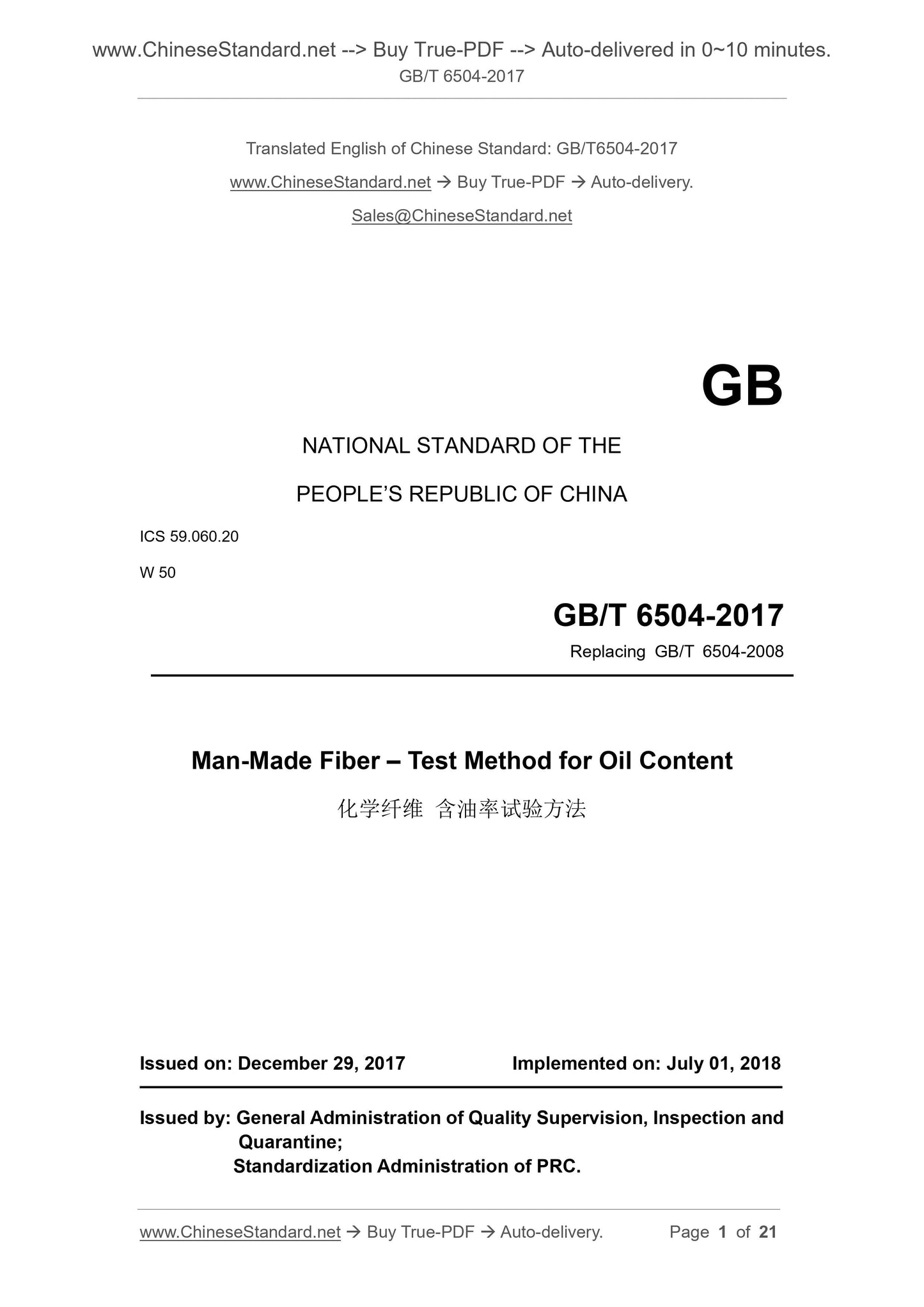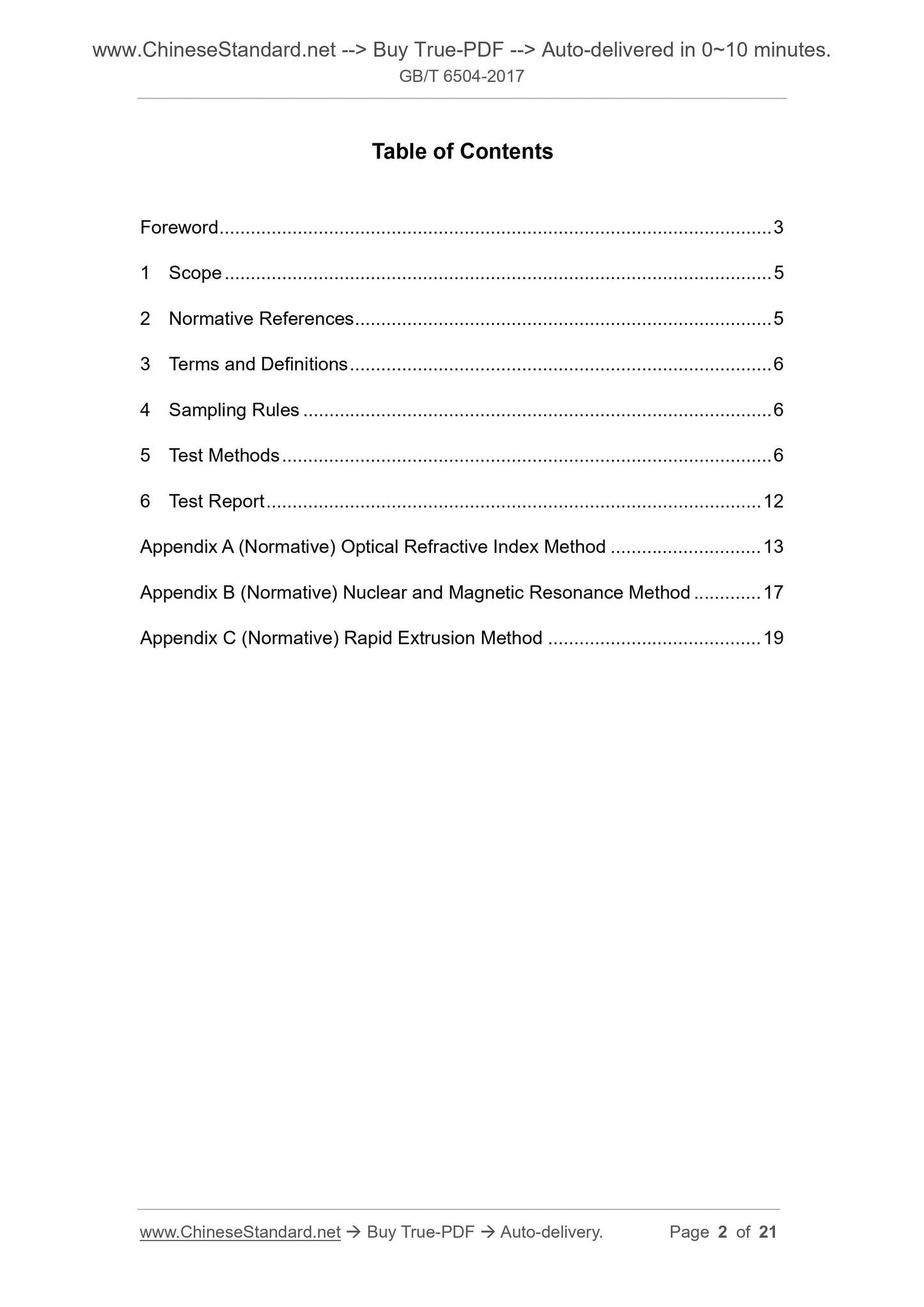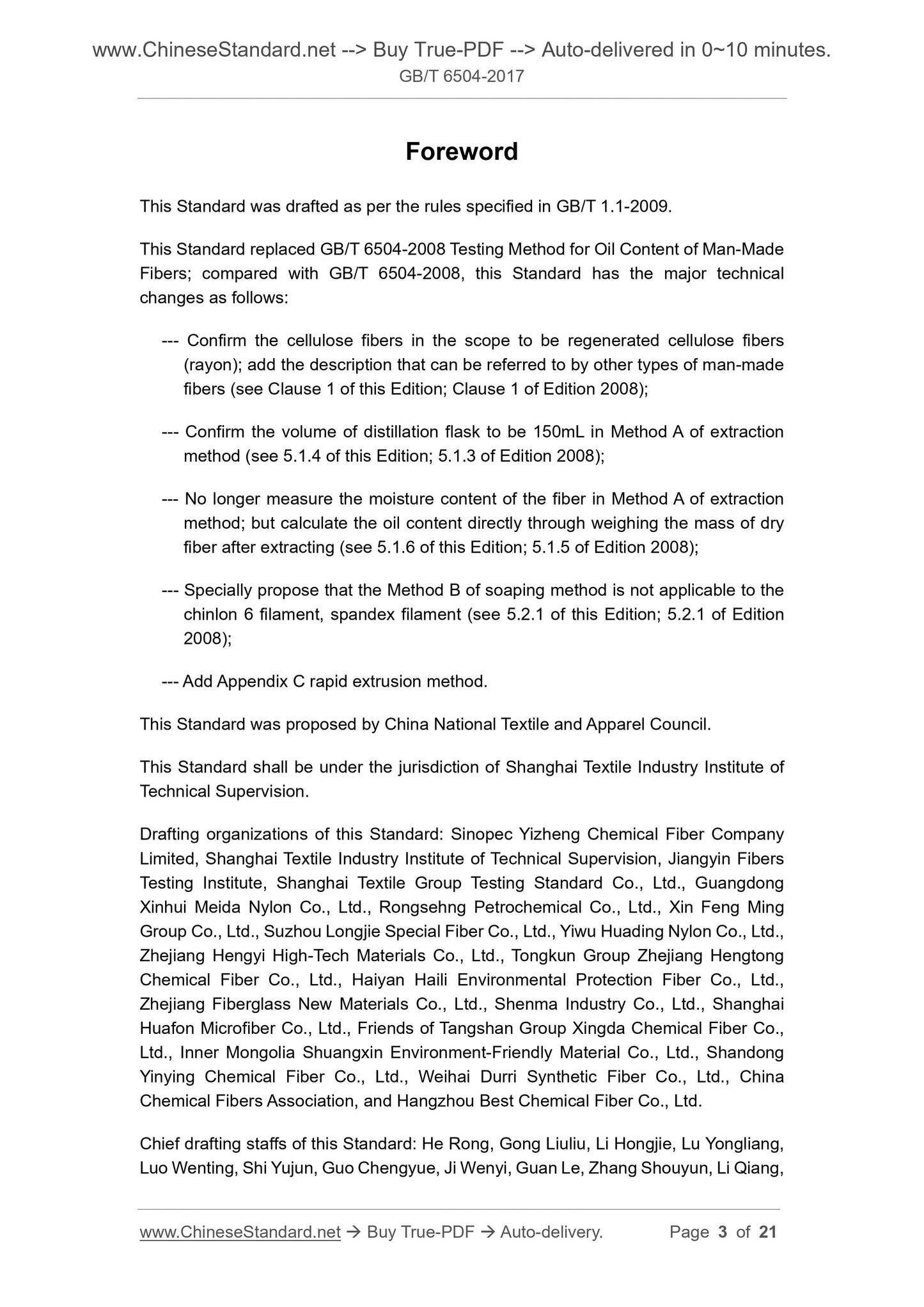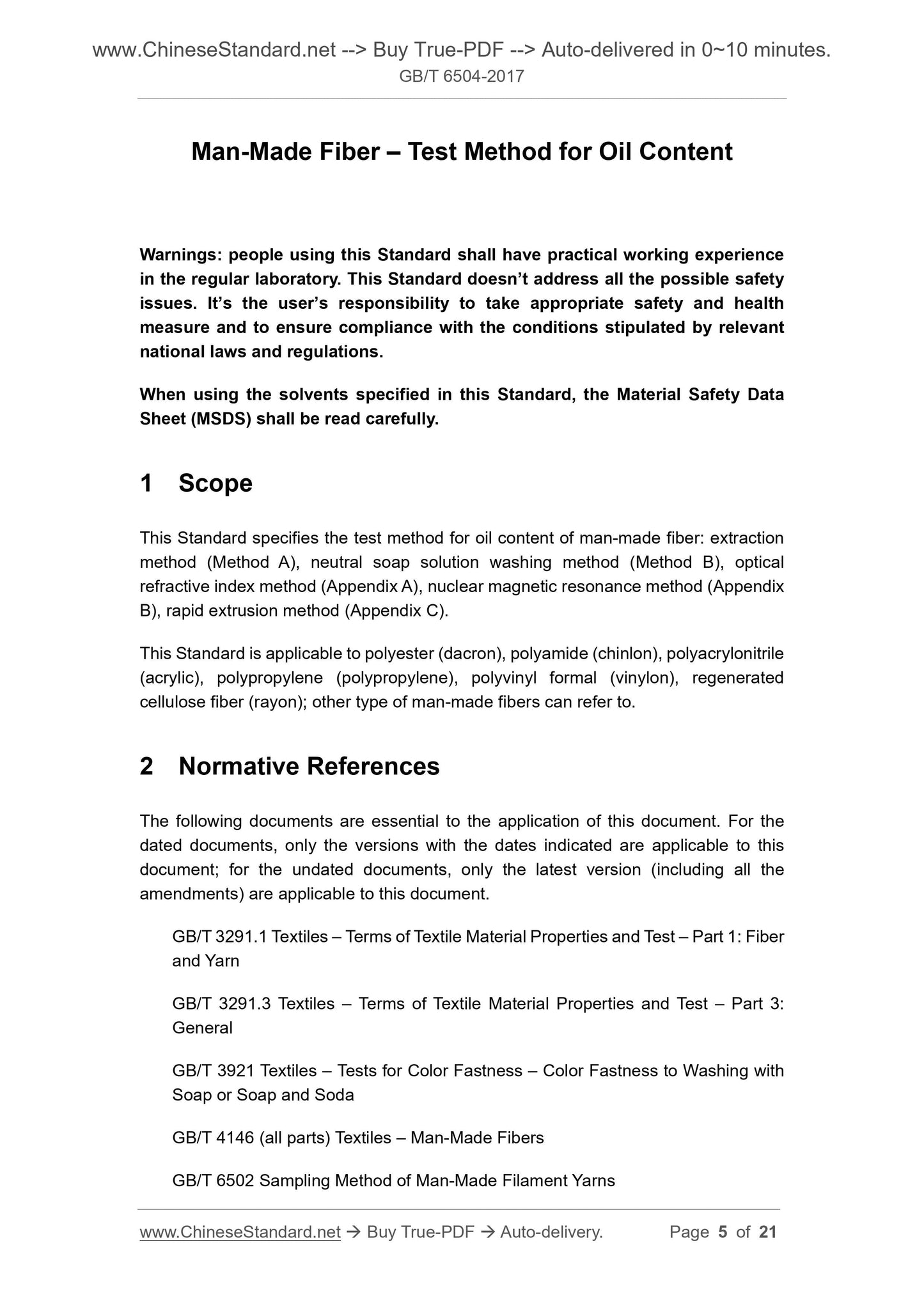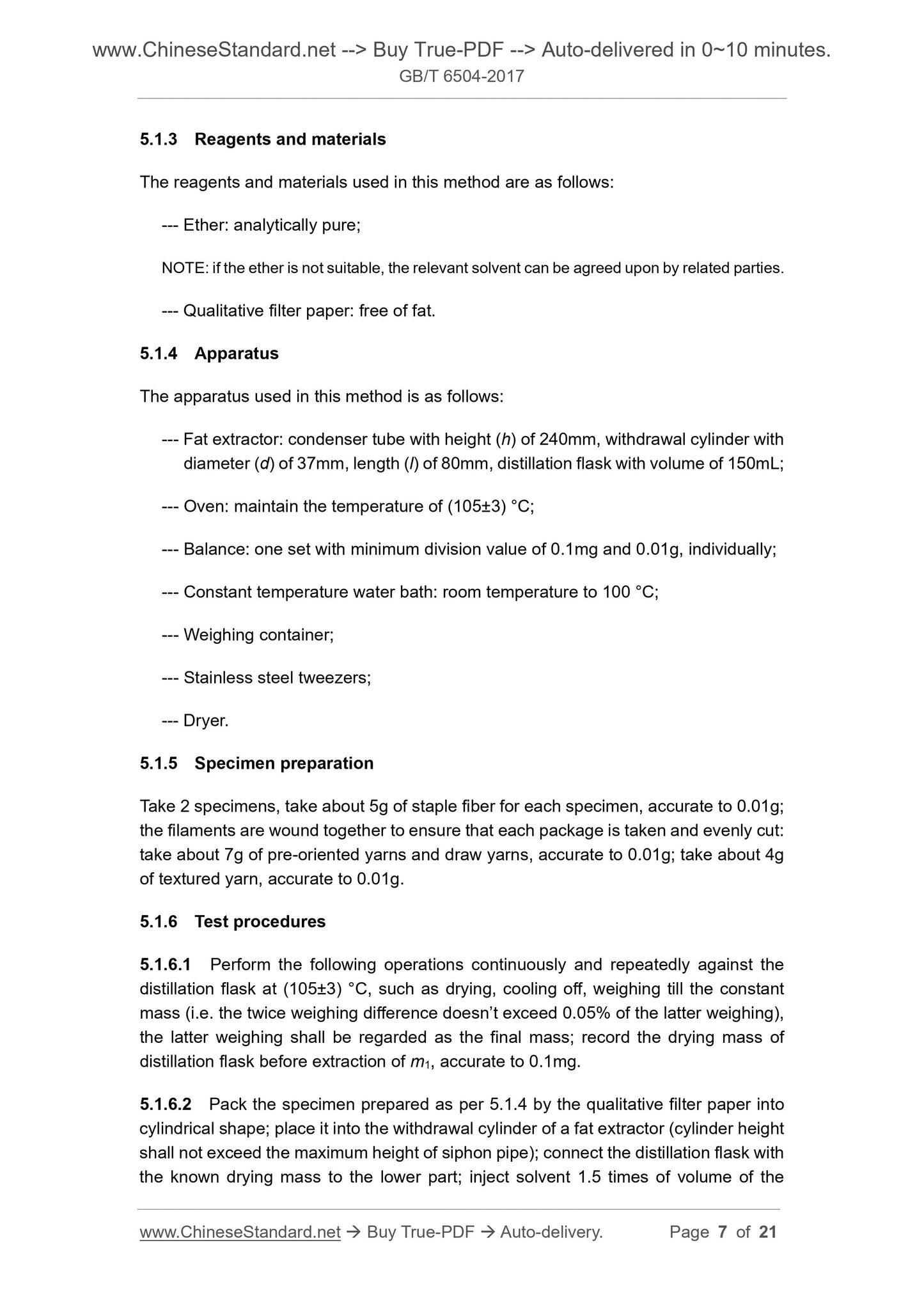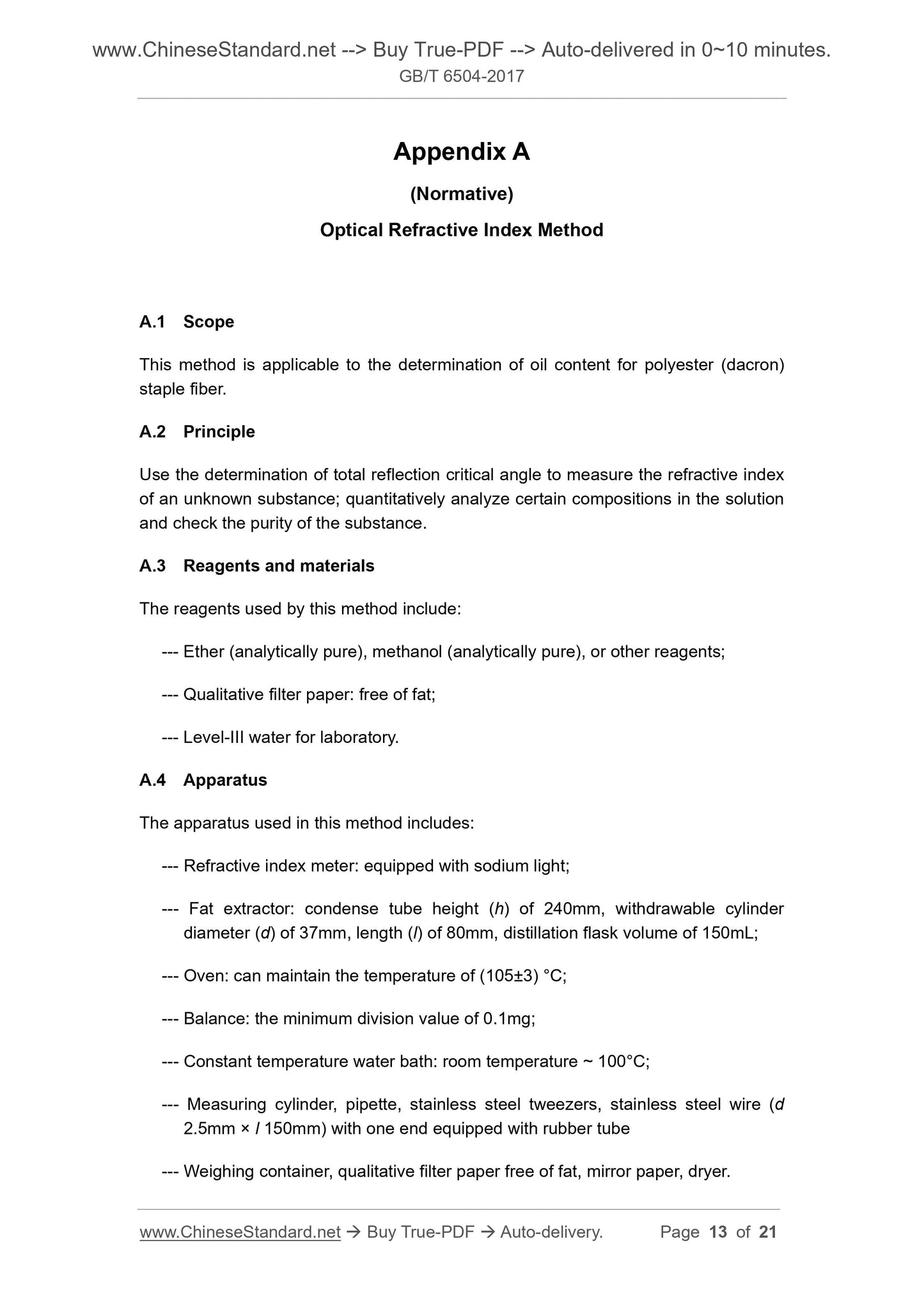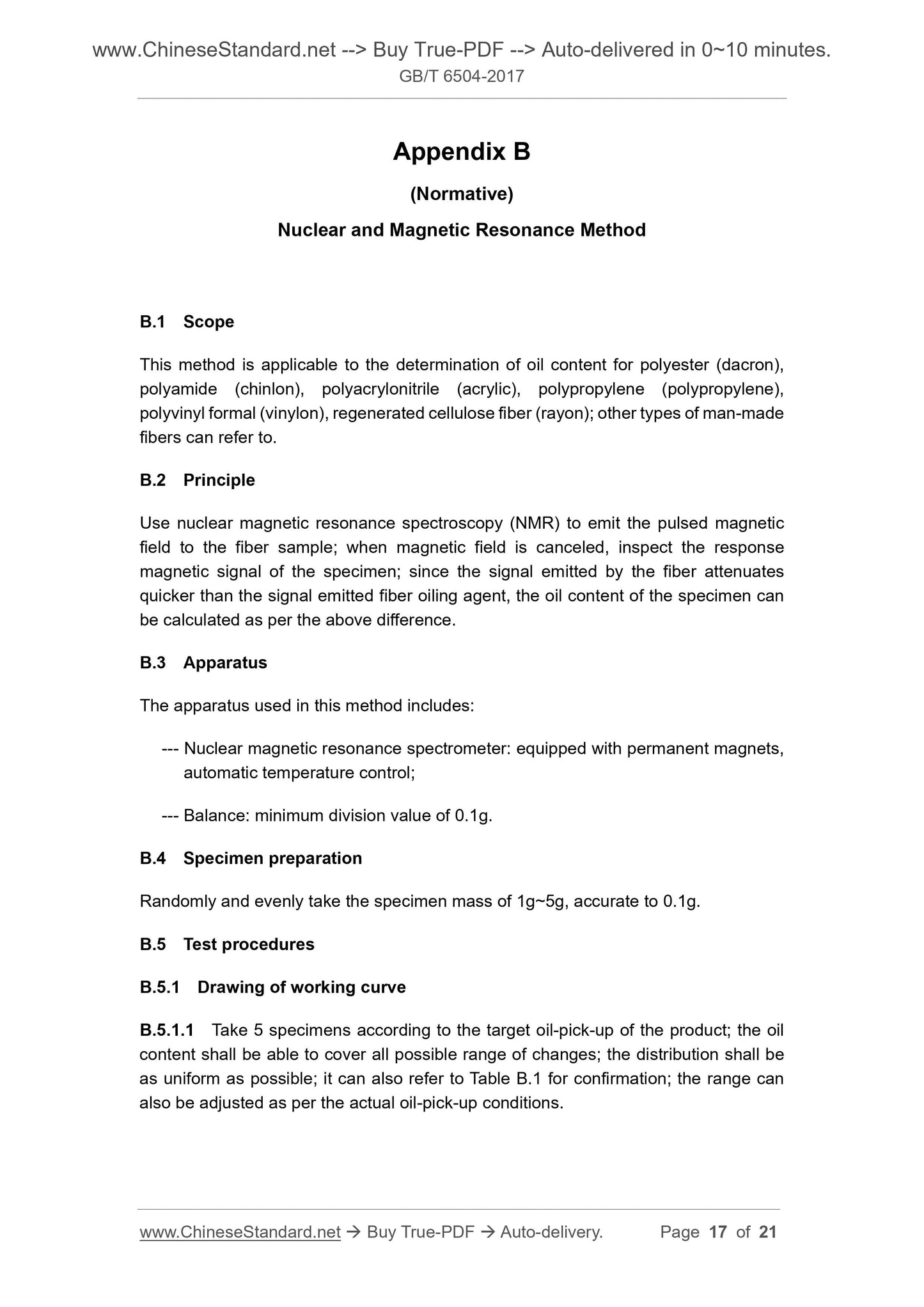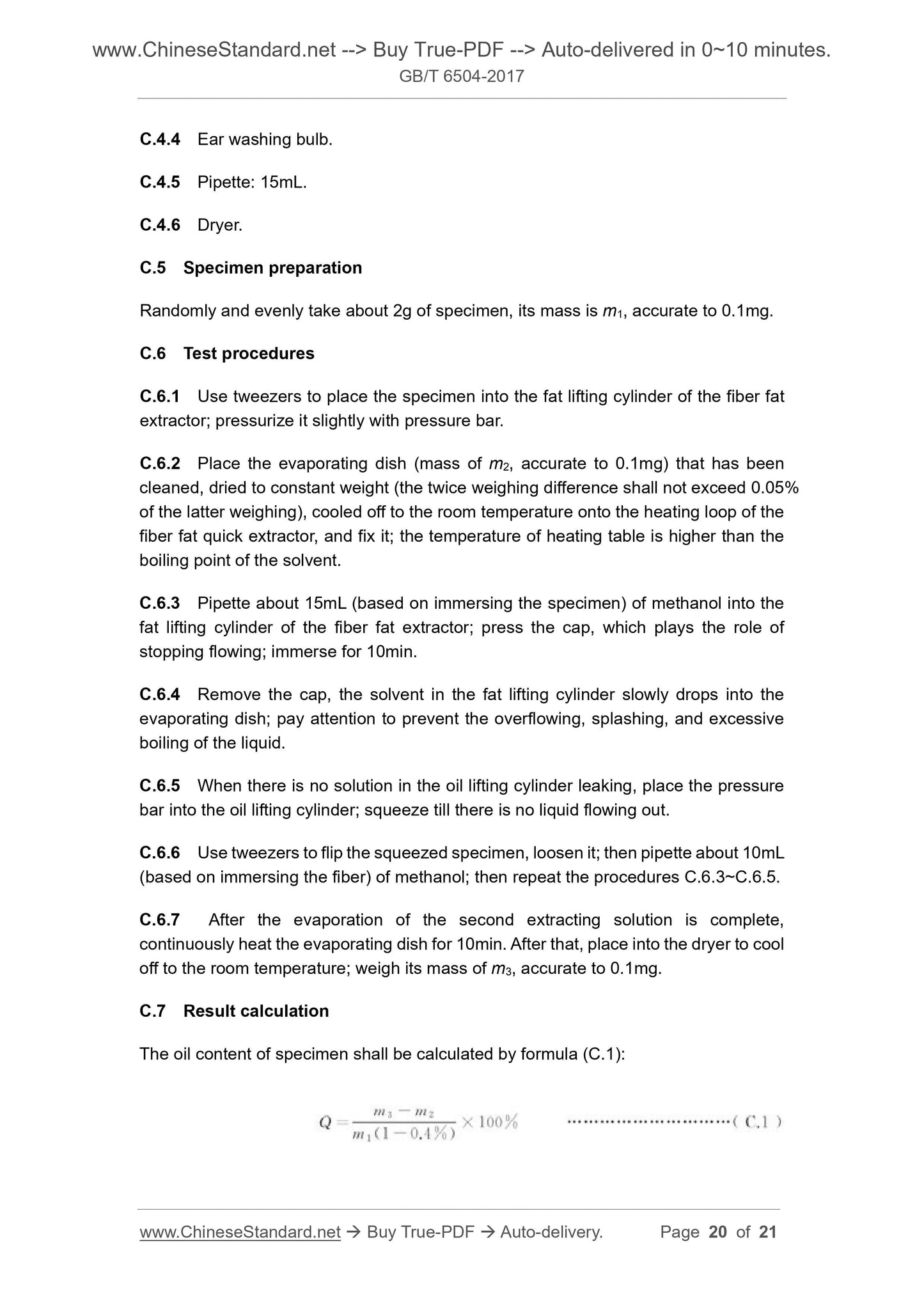1
/
of
8
PayPal, credit cards. Download editable-PDF & invoice in 1 second!
GB/T 6504-2017 English PDF (GBT6504-2017)
GB/T 6504-2017 English PDF (GBT6504-2017)
Regular price
$210.00 USD
Regular price
Sale price
$210.00 USD
Unit price
/
per
Shipping calculated at checkout.
Couldn't load pickup availability
Delivery: 3 seconds. Download true-PDF + Invoice.
Get QUOTATION in 1-minute: Click GB/T 6504-2017
Historical versions: GB/T 6504-2017
Preview True-PDF (Reload/Scroll if blank)
GB/T 6504-2017: Man-made fiber -- Test method for oil content
NATIONAL STANDARD OF THE
PEOPLE’S REPUBLIC OF CHINA
ICS 59.060.20 W 50
GB/T 6504-2017
Replacing GB/T 6504-2008
Man-Made Fiber – Test Method for Oil Content
Issued on. December 29, 2017 Implemented on. July 01, 2018
Issued by. General Administration of Quality Supervision, Inspection and Quarantine; Standardization Administration of PRC.
Table of Contents
Foreword ... 3
1 Scope ... 5
2 Normative References ... 5
3 Terms and Definitions ... 6
4 Sampling Rules ... 6
5 Test Methods ... 6
6 Test Report ... 12
Appendix A (Normative) Optical Refractive Index Method ... 13
Appendix B (Normative) Nuclear and Magnetic Resonance Method ... 17
Appendix C (Normative) Rapid Extrusion Method ... 19
Foreword
This Standard was drafted as per the rules specified in GB/T 1.1-2009.
This Standard replaced GB/T 6504-2008 Testing Method for Oil Content of Man-Made Fibers; compared with GB/T 6504-2008, this Standard has the major technical changes as follows.
---Confirm the cellulose fibers in the scope to be regenerated cellulose fibers (rayon); add the description that can be referred to by other types of man-made fibers (see Clause 1 of this Edition; Clause 1 of Edition 2008);
---Confirm the volume of distillation flask to be 150mL in Method A of extraction method (see 5.1.4 of this Edition; 5.1.3 of Edition 2008);
--- No longer measure the moisture content of the fiber in Method A of extraction method; but calculate the oil content directly through weighing the mass of dry fiber after extracting (see 5.1.6 of this Edition; 5.1.5 of Edition 2008);
--- Specially propose that the Method B of soaping method is not applicable to the chinlon 6 filament, spandex filament (see 5.2.1 of this Edition; 5.2.1 of Edition 2008);
--- Add Appendix C rapid extrusion method.
This Standard was proposed by China National Textile and Apparel Council.
This Standard shall be under the jurisdiction of Shanghai Textile Industry Institute of Technical Supervision.
Drafting organizations of this Standard. Sinopec Yizheng Chemical Fiber Company Limited, Shanghai Textile Industry Institute of Technical Supervision, Jiangyin Fibers Testing Institute, Shanghai Textile Group Testing Standard Co., Ltd., Guangdong Xinhui Meida Nylon Co., Ltd., Rongsehng Petrochemical Co., Ltd., Xin Feng Ming Group Co., Ltd., Suzhou Longjie Special Fiber Co., Ltd., Yiwu Huading Nylon Co., Ltd., Zhejiang Hengyi High-Tech Materials Co., Ltd., Tongkun Group Zhejiang Hengtong Chemical Fiber Co., Ltd., Haiyan Haili Environmental Protection Fiber Co., Ltd., Zhejiang Fiberglass New Materials Co., Ltd., Shenma Industry Co., Ltd., Shanghai Huafon Microfiber Co., Ltd., Friends of Tangshan Group Xingda Chemical Fiber Co., Ltd., Inner Mongolia Shuangxin Environment-Friendly Material Co., Ltd., Shandong Yinying Chemical Fiber Co., Ltd., Weihai Durri Synthetic Fiber Co., Ltd., China Chemical Fibers Association, and Hangzhou Best Chemical Fiber Co., Ltd.
Chief drafting staffs of this Standard. He Rong, Gong Liuliu, Li Hongjie, Lu Yongliang, Luo Wenting, Shi Yujun, Guo Chengyue, Ji Wenyi, Guan Le, Zhang Shouyun, Li Qiang,
Man-Made Fiber – Test Method for Oil Content
Warnings. people using this Standard shall have practical working experience in the regular laboratory. This Standard doesn’t address all the possible safety issues. It’s the user’s responsibility to take appropriate safety and health measure and to ensure compliance with the conditions stipulated by relevant national laws and regulations.
When using the solvents specified in this Standard, the Material Safety Data Sheet (MSDS) shall be read carefully.
1 Scope
This Standard specifies the test method for oil content of man-made fiber. extraction method (Method A), neutral soap solution washing method (Method B), optical refractive index method (Appendix A), nuclear magnetic resonance method (Appendix B), rapid extrusion method (Appendix C).
This Standard is applicable to polyester (dacron), polyamide (chinlon), polyacrylonitrile (acrylic), polypropylene (polypropylene), polyvinyl formal (vinylon), regenerated cellulose fiber (rayon); other type of man-made fibers can refer to.
2 Normative References
The following documents are essential to the application of this document. For the dated documents, only the versions with the dates indicated are applicable to this document; for the undated documents, only the latest version (including all the amendments) are applicable to this document.
GB/T 3291.1 Textiles – Terms of Textile Material Properties and Test – Part 1. Fiber and Yarn
GB/T 3291.3 Textiles – Terms of Textile Material Properties and Test – Part 3. General
GB/T 3921 Textiles – Tests for Color Fastness – Color Fastness to Washing with Soap or Soap and Soda
GB/T 4146 (all parts) Textiles – Man-Made Fibers
GB/T 6502 Sampling Method of Man-Made Filament Yarns
5.1.3 Reagents and materials
The reagents and materials used in this method are as follows. --- Ether. analytically pure; NOTE. if the ether is not suitable, the relevant solvent can be agreed upon by related parties. --- Qualitative filter paper. free of fat.
5.1.4 Apparatus
The apparatus used in this method is as follows. --- Fat extractor. condenser tube with height (h) of 240mm, withdrawal cylinder with
diameter (d) of 37mm, length (l) of 80mm, distillation flask with volume of 150mL; --- Oven. maintain the temperature of (105±3) °C; --- Balance. one set with minimum division value of 0.1mg and 0.01g, individually; --- Constant temperature water bath. room temperature to 100 °C; --- Weighing container; --- Stainless steel tweezers; --- Dryer.
5.1.5 Specimen preparation
Take 2 specimens, take about 5g of staple fiber for each specimen, accurate to 0.01g; the filaments are wound together to ensure that each package is taken and evenly cut. take about 7g of pre-oriented yarns and draw yarns, accurate to 0.01g; take about 4g of textured yarn, accurate to 0.01g.
5.1.6 Test procedures
5.1.6.1 Perform the following operations continuously and repeatedly against the distillation flask at (105±3) °C, such as drying, cooling off, weighing till the constant mass (i.e. the twice weighing difference doesn’t exceed 0.05% of the latter weighing), the latter weighing shall be regarded as the final mass; record the drying mass of distillation flask before extraction of m1, accurate to 0.1mg.
5.1.6.2 Pack the specimen prepared as per 5.1.4 by the qualitative filter paper into cylindrical shape; place it into the withdrawal cylinder of a fat extractor (cylinder height shall not exceed the maximum height of siphon pipe); connect the distillation flask with the known drying mass to the lower part; inject solvent 1.5 times of volume of the
Appendix A
(Normative)
Optical Refractive Index Method
A.1 Scope
This method is applicable to the determination of oil content for polyester (dacron) staple fiber.
A.2 Principle
Use the determination of total reflection critical angle to measure the refractive index of an unknown substance; quantitatively analyze certain compositions in the solution and check the purity of the substance.
A.3 Reagents and materials
The reagents used by this method include.
--- Ether (analytically pure), methanol (analytically pure), or other reagents;
--- Qualitative filter paper. free of fat;
--- Level-III water for laboratory.
A.4 Apparatus
The apparatus used in this method includes.
--- Refractive index meter. equipped with sodium light;
---Fat extractor. condense tube height (h) of 240mm, withdrawable cylinder
diameter (d) of 37mm, length (l) of 80mm, distillation flask volume of 150mL; --- Oven. can maintain the temperature of (105±3) °C; --- Balance. the minimum divis...
Get QUOTATION in 1-minute: Click GB/T 6504-2017
Historical versions: GB/T 6504-2017
Preview True-PDF (Reload/Scroll if blank)
GB/T 6504-2017: Man-made fiber -- Test method for oil content
NATIONAL STANDARD OF THE
PEOPLE’S REPUBLIC OF CHINA
ICS 59.060.20 W 50
GB/T 6504-2017
Replacing GB/T 6504-2008
Man-Made Fiber – Test Method for Oil Content
Issued on. December 29, 2017 Implemented on. July 01, 2018
Issued by. General Administration of Quality Supervision, Inspection and Quarantine; Standardization Administration of PRC.
Table of Contents
Foreword ... 3
1 Scope ... 5
2 Normative References ... 5
3 Terms and Definitions ... 6
4 Sampling Rules ... 6
5 Test Methods ... 6
6 Test Report ... 12
Appendix A (Normative) Optical Refractive Index Method ... 13
Appendix B (Normative) Nuclear and Magnetic Resonance Method ... 17
Appendix C (Normative) Rapid Extrusion Method ... 19
Foreword
This Standard was drafted as per the rules specified in GB/T 1.1-2009.
This Standard replaced GB/T 6504-2008 Testing Method for Oil Content of Man-Made Fibers; compared with GB/T 6504-2008, this Standard has the major technical changes as follows.
---Confirm the cellulose fibers in the scope to be regenerated cellulose fibers (rayon); add the description that can be referred to by other types of man-made fibers (see Clause 1 of this Edition; Clause 1 of Edition 2008);
---Confirm the volume of distillation flask to be 150mL in Method A of extraction method (see 5.1.4 of this Edition; 5.1.3 of Edition 2008);
--- No longer measure the moisture content of the fiber in Method A of extraction method; but calculate the oil content directly through weighing the mass of dry fiber after extracting (see 5.1.6 of this Edition; 5.1.5 of Edition 2008);
--- Specially propose that the Method B of soaping method is not applicable to the chinlon 6 filament, spandex filament (see 5.2.1 of this Edition; 5.2.1 of Edition 2008);
--- Add Appendix C rapid extrusion method.
This Standard was proposed by China National Textile and Apparel Council.
This Standard shall be under the jurisdiction of Shanghai Textile Industry Institute of Technical Supervision.
Drafting organizations of this Standard. Sinopec Yizheng Chemical Fiber Company Limited, Shanghai Textile Industry Institute of Technical Supervision, Jiangyin Fibers Testing Institute, Shanghai Textile Group Testing Standard Co., Ltd., Guangdong Xinhui Meida Nylon Co., Ltd., Rongsehng Petrochemical Co., Ltd., Xin Feng Ming Group Co., Ltd., Suzhou Longjie Special Fiber Co., Ltd., Yiwu Huading Nylon Co., Ltd., Zhejiang Hengyi High-Tech Materials Co., Ltd., Tongkun Group Zhejiang Hengtong Chemical Fiber Co., Ltd., Haiyan Haili Environmental Protection Fiber Co., Ltd., Zhejiang Fiberglass New Materials Co., Ltd., Shenma Industry Co., Ltd., Shanghai Huafon Microfiber Co., Ltd., Friends of Tangshan Group Xingda Chemical Fiber Co., Ltd., Inner Mongolia Shuangxin Environment-Friendly Material Co., Ltd., Shandong Yinying Chemical Fiber Co., Ltd., Weihai Durri Synthetic Fiber Co., Ltd., China Chemical Fibers Association, and Hangzhou Best Chemical Fiber Co., Ltd.
Chief drafting staffs of this Standard. He Rong, Gong Liuliu, Li Hongjie, Lu Yongliang, Luo Wenting, Shi Yujun, Guo Chengyue, Ji Wenyi, Guan Le, Zhang Shouyun, Li Qiang,
Man-Made Fiber – Test Method for Oil Content
Warnings. people using this Standard shall have practical working experience in the regular laboratory. This Standard doesn’t address all the possible safety issues. It’s the user’s responsibility to take appropriate safety and health measure and to ensure compliance with the conditions stipulated by relevant national laws and regulations.
When using the solvents specified in this Standard, the Material Safety Data Sheet (MSDS) shall be read carefully.
1 Scope
This Standard specifies the test method for oil content of man-made fiber. extraction method (Method A), neutral soap solution washing method (Method B), optical refractive index method (Appendix A), nuclear magnetic resonance method (Appendix B), rapid extrusion method (Appendix C).
This Standard is applicable to polyester (dacron), polyamide (chinlon), polyacrylonitrile (acrylic), polypropylene (polypropylene), polyvinyl formal (vinylon), regenerated cellulose fiber (rayon); other type of man-made fibers can refer to.
2 Normative References
The following documents are essential to the application of this document. For the dated documents, only the versions with the dates indicated are applicable to this document; for the undated documents, only the latest version (including all the amendments) are applicable to this document.
GB/T 3291.1 Textiles – Terms of Textile Material Properties and Test – Part 1. Fiber and Yarn
GB/T 3291.3 Textiles – Terms of Textile Material Properties and Test – Part 3. General
GB/T 3921 Textiles – Tests for Color Fastness – Color Fastness to Washing with Soap or Soap and Soda
GB/T 4146 (all parts) Textiles – Man-Made Fibers
GB/T 6502 Sampling Method of Man-Made Filament Yarns
5.1.3 Reagents and materials
The reagents and materials used in this method are as follows. --- Ether. analytically pure; NOTE. if the ether is not suitable, the relevant solvent can be agreed upon by related parties. --- Qualitative filter paper. free of fat.
5.1.4 Apparatus
The apparatus used in this method is as follows. --- Fat extractor. condenser tube with height (h) of 240mm, withdrawal cylinder with
diameter (d) of 37mm, length (l) of 80mm, distillation flask with volume of 150mL; --- Oven. maintain the temperature of (105±3) °C; --- Balance. one set with minimum division value of 0.1mg and 0.01g, individually; --- Constant temperature water bath. room temperature to 100 °C; --- Weighing container; --- Stainless steel tweezers; --- Dryer.
5.1.5 Specimen preparation
Take 2 specimens, take about 5g of staple fiber for each specimen, accurate to 0.01g; the filaments are wound together to ensure that each package is taken and evenly cut. take about 7g of pre-oriented yarns and draw yarns, accurate to 0.01g; take about 4g of textured yarn, accurate to 0.01g.
5.1.6 Test procedures
5.1.6.1 Perform the following operations continuously and repeatedly against the distillation flask at (105±3) °C, such as drying, cooling off, weighing till the constant mass (i.e. the twice weighing difference doesn’t exceed 0.05% of the latter weighing), the latter weighing shall be regarded as the final mass; record the drying mass of distillation flask before extraction of m1, accurate to 0.1mg.
5.1.6.2 Pack the specimen prepared as per 5.1.4 by the qualitative filter paper into cylindrical shape; place it into the withdrawal cylinder of a fat extractor (cylinder height shall not exceed the maximum height of siphon pipe); connect the distillation flask with the known drying mass to the lower part; inject solvent 1.5 times of volume of the
Appendix A
(Normative)
Optical Refractive Index Method
A.1 Scope
This method is applicable to the determination of oil content for polyester (dacron) staple fiber.
A.2 Principle
Use the determination of total reflection critical angle to measure the refractive index of an unknown substance; quantitatively analyze certain compositions in the solution and check the purity of the substance.
A.3 Reagents and materials
The reagents used by this method include.
--- Ether (analytically pure), methanol (analytically pure), or other reagents;
--- Qualitative filter paper. free of fat;
--- Level-III water for laboratory.
A.4 Apparatus
The apparatus used in this method includes.
--- Refractive index meter. equipped with sodium light;
---Fat extractor. condense tube height (h) of 240mm, withdrawable cylinder
diameter (d) of 37mm, length (l) of 80mm, distillation flask volume of 150mL; --- Oven. can maintain the temperature of (105±3) °C; --- Balance. the minimum divis...
Share
